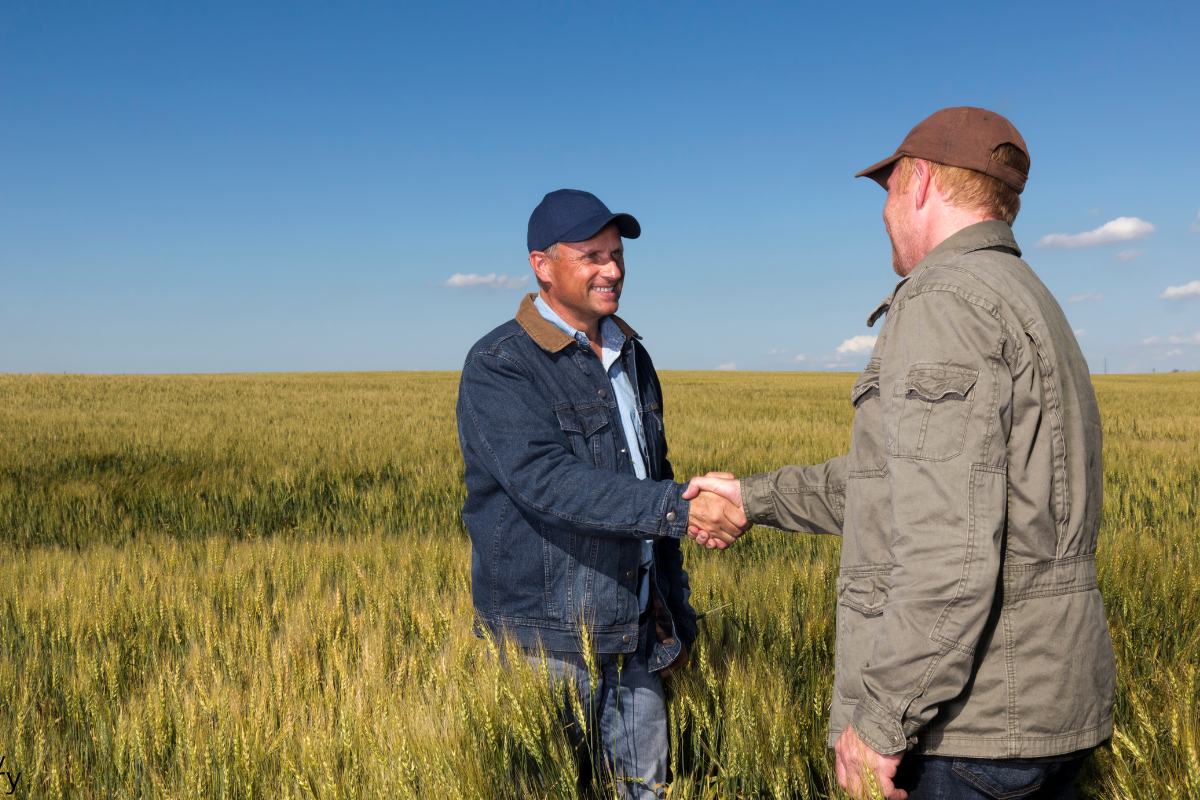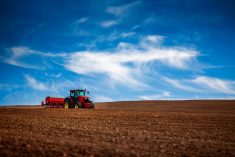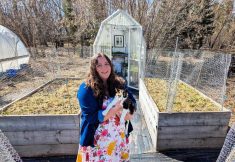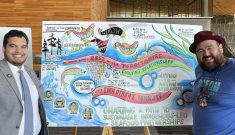The story of the Opaskwayak Smart Farm at Opaskwayak Cree Nation in The Pas, Man., starts with an improbable rescue.
It was 2013. A group of hunters from OCN were way out in the bush when they stumbled upon a car stuck in the mud on a remote dirt road.
The car belonged to a group of South Korean delegates visiting Manitoba to bid on the Bipole 3 project with Manitoba Hydro. They’d been out surveying. Then they’d gotten stuck.
Read Also

Are you ready for farm succession?
What motivates some farmers to make a succession plan while others don’t seem worried.
The hunters brought them into town and bought them a coffee.

It was the start of a deep friendship, says Stephanie Cook, operations manager at the Smart Farm.
The Korean delegation included the late Isaac Young, a businessman with connections to a company called Korea Agriculture Systems & Technology Engineering Co. Ltd. (KAST).
Young began visiting OCN as often as possible, spending weeks at a time in the community and forming close relationships with OCN members, including Glen Ross, executive director at the OCN Health Authority.
Young had read a health study conducted at OCN that showed exceedingly high local rates of diabetes — nearly 50 per cent of the population — and that predicted the community was on course to spend billions on health conditions related to diabetes over a 10-year period.
Young was alarmed by it. “He asked how we could make a change,” says Cook.
It was Young who proposed setting up an LED vertical “smart farm” at the reserve to try growing fruits and vegetables locally, using KAST technology with support from the business incubator GyeongBuk TechnoPark (GBTP) in Gyeongbuk Province in South Korea.
The idea was initially met with hesitation by reserve leadership — for good reason. The Pas has an average of only 100 frost-free days per year. The last spring frost can happen at the end of June or even the beginning of July; the first autumn frost can hit mid-August. It takes flexibility and skill to grow any vegetable crop in The Pas. Many things can’t be grown at all.
The idea of growing lettuce in an indoor, soil-free, water-based system 365 days a year seemed like something out of a science fiction movie.

But by February 2016 the project was underway. Then Cook, who was working at the bank, was approached by OCN leadership about a new career opportunity. She was asked to stop by the community hall with her resumé.
When Cook arrived at the hall she was astonished to find the room filled with huge piles of aluminum-wrapped packages and lighting bars wrapped in styrofoam. She asked to see blueprints and realized she was looking at the raw materials for a huge hydroponic system.
“I thought, ‘You guys are nuts. This is never going to work here.’ They said, ‘It can run 365 days a year.’ I thought, ‘You’re not God! You’re going to have mutant plants coming out of this room!’ But we started helping them assemble it — five Koreans and five local staff — and within seven days we had everything put together.”
The system, she says, is basically a big aquarium, with UV filters and aerator pucks inside the main tanks, and feeding tanks. A computer runs the feeding and lighting systems and monitors CO2 and pH levels, and provides data to optimize growth and energy consumption.
The technology was designed to grow leafy greens. But Young, who quickly became Cook’s mentor, sent her packets of more than 100 seed varieties, urging her to see what the system could do.
Since then, the OCN Smart Farm has successfully grown 76 types of fruits and vegetables, including root vegetables, radishes, leeks, strawberries, bitter melons and many varieties of leafy greens.
“I didn’t eat any of our first crop,” says Cook. “I was too scared of it. I grew up in an ag family (with) the idea that everything comes from soil. It took me about a month to get comfortable eating it.” But Young said if Cook grew produce for the community, she had to try it herself.
At last, she took a leaf of lettuce and dipped it in balsamic vinegar.
She hasn’t looked back. Nothing trucked into the community tastes as good as what the Smart Farm can produce. Smart Farm lettuce lasts three times longer than lettuce that comes off the truck. And when strawberries cost $15 a pound at the grocery store, Smart Farm strawberries taste extremely sweet.
But the key to Smart Farm’s success has as much to do with local buy-in as it does the technology.
Past and present barriers
After hundreds of years of decline, a direct result of “government policies, legislation and interventions aiming to dispossess and disenfranchise Indigenous Peoples of their lands and cultures,” Agriculture and Agri-Food Canada (AAFC) says Indigenous-led agriculture has begun to grow again in Canada.
But Indigenous-led farming operations are still few and far between. How few? Even that is a difficult question without a clear consensus on how exactly Indigenous farms should be defined and surveyed.
“Indigenous people tried for a long time to farm, to ranch, to have their own property and exert their knowledge and skills. They (were successful), and that created competition that settlers didn’t like. This is still with us” says Claire Thomson, a historian with Parks Canada who works remotely from her family’s ranch in southern Saskatchewan.
“We think of Canadian farming as being non-Indigenous … There’s still a myth that Indigenous people aren’t interested in agriculture. That’s a dichotomy that still exists in Canada, this ‘cowboys-and-Indians’ binary.”

Thomson, who is non-status Lakota on her father’s side, studied with Sarah Carter, whose famous first book Lost Harvests documented Western Canada’s colonial history and government camp aigns to disenfranchise Indigenous Peoples.
Thomson says Carter’s work was instrumental in helping overturn the misconception that Indigenous people on the Prairies were not successful or interested in agriculture.
“Indigenous peoples in North America practised agriculture prior to contact and after contact as well, not necessarily always in the way our department would define agriculture–it was holistic,” says Emily Missyabit McAuley, director of the Indigenous Science Liaison Office and Interdepartmental Indigenous STEM (I-STEM) Cluster at AAFC.
“There was a whole food system built around community structures and family that was really disrupted, sometimes intentionally and sometimes unintentionally,” McAuley says.
McAuley is Ojibwa; she says her perspective is rooted in her identity. When she thinks of the Canadian government’s relationship with Indigenous Peoples, her mind goes first to the reserve system. In many cases reserve lands are located away from prime arable land.
Later policies such as the pass-and-permit system, which required Indigenous farmers to apply for passes to leave the reserve to sell their produce, further reduced their competitiveness, as did the detrimental and draconian Peasant Farming Policy directed against First Nations agriculture.
Even the treaties that promised agricultural provisions — seeds, supplies and equipment — were abused.
“In a lot of cases the provisions weren’t delivered, or they came too late in the season, or implements were not in good condition or not appropriate for the climate or land. That reduced the level of agriculture that Indigenous folks were able to engage (in). And on reserves the amount of land farmers could use would be small. It was assumed farmers would just support their own families. It was difficult for them to engage in larger-scale farming,” McAuley says.
The pass system was permanently dismantled everywhere in Canada by 1951. But the damage this policy and the others did to Indigenous farmers was incalculable.
These days, says McAuley, Indigenous farmers still face barriers in agriculture, including — but far from limited to — a lack of land, inability to leverage reserve property (technically Crown land) to take out farm loans, and socioeconomic barriers, including lack of access to farm business training.
In addition, the legacy of the residential school system, which often used farm labour as punishment, indelibly linked farming with settler colonialism for generations of Indigenous people.

Funding problems
But perhaps the biggest barrier for Indigenous farmers is lack of access to funding. Kyle Bobiwash, an assistant professor and Indigenous Scholar in the University of Manitoba’s department of entomology, says funding is often tied to highly specific projects — such as those geared at climate change.
“Part of the problem is lack of flexibility in all of our systems, (including) the financing system, and people are trying to figure that out. Not just Indigenous (folks) but young farmers. How do you get financing in a way that doesn’t burden you for the rest of your life? That pressure means you have to farm a particular way with particular crops, something that has crop insurance returns — all these things play a role in shaping our ag industry,” Bobiwash says.
Cook says that in the North it’s particularly difficult to fund ag projects, such as the Smart Farm — even though its produce is directed at community food insecurity. Not all reserves are as well-resourced as OCN.
“Funding avenues that are available (tend to be) for traditional agriculture,” Cook says. “But First Nations agriculture falls under a different field than traditional agriculture.”
Bobiwash says many small grants are available to Indigenous farmers and communities, but these tend to be geared at preliminary research or efforts such as preplanting. It’s also difficult for individuals to apply for funding on their own; on reserves, sign-off has to come via multiple layers of administration.
What this means is that agricultural research projects that happen on reserves are often inherently risk-averse, so that communities that take them on don’t compromise their ability to seek future funding.
“People that are struggling don’t have the opportunity to take the same risks. It needs to be a sure shot that won’t fail,” says Bobiwash. “(But) sometimes you need to be able to access money that’s really wide open.”

AAFC says demand for economic development opportunities geared at Indigenous-led agriculture has been extremely high, with targeted programs often oversubscribed.
The department’s Indigenous Agriculture Food Systems Initiative, an $8.5 million dollar program that began in 2018 and is set to run until 2023, has already closed to new applicants for its final year. Another program, the Local Food Infrastructure Fund (2019-24), which supports agricultural infrastructure projects in food-insecure communities, closed to applicants this summer.
But the department also has permanent programing in place that aims to improve relationships between Indigenous groups and government agencies.
McAuley says the Indigenous Science Liaison Office works with Indigenous groups across the country, which work in turn with local communities to re-establish trust and then co-develop agricultural research projects that respond to needs in Indigenous communities.
The I-STEM Cluster, she says, is a cluster of federal departments that work together across all 13 departments to “pool best practices and develop new approaches to respond to Indigenous research priorities more holistically.”
“So rather than going to a community and saying, ‘What are your ag research needs, what are your fisheries and forestry research needs,’ we work together in a concerted way that’s less reductive,” McAuley says.
McAuley’s vision is one in which all people in Canada are fed via a vibrant agricultural food sector. But it’s also one in which Indigenous communities are positioned as leaders in the struggle to build more resilient systems in the face of climate change.
“Indigenous Peoples were the stewards and continue to be the stewards of the land in Canada and they had been for thousands of years prior to colonization. When we talk about climate change and (building) resilience in the ag sector to respond to more drought, more floods and less predictability — there are knowledge systems that were developed and refined here for thousands of years that in order to survive had to be locally adapted and integrated,” McAuley says.
“For the longest time Indigenous people have been barred from growing and sharing that knowledge.”
Indigenous ways of knowing
In his research, Bobiwash doesn’t necessarily aim for “Indigenous” projects, but for interesting ecology and land projects. This summer he’s beginning a new project that will explore the value of the Three Sisters planting method (companion-planted corn, beans and squash) at several research plots in Manitoba and Ontario, including Brokenhead Ojibway Nation in Scanterbury, Man.
“Our idea with the Three Sisters was that we wanted to set up a conventional scientific layout, a complete design, and from that look at changes in productivity, but at the rest of that ecological system — not just (the) farm production system, but how it affects pollinators, pests,” he says. The study will potentially also look at effects on the soil microbiome and other impacts on the environment.

It’s an attempt to do something community-focused, says Bobiwash; the hope is that Indigenous communities can use the experimental areas to ask questions of their own.
Bobiwash says that within academia , there’s a lack of trust that Indigenous voices really matter at the table.
He’s seen first-hand how difficult it can be for Indigenous students to integrate into the university system. As Indigenous Scholar, he isn’t provided extra resources to do community-building exercises, but he does what he can while completing the research activities that come with his job.
But even as a professor within a Western education system, Bobiwash doesn’t always feel accepted. It can be tough, he says, to convince Indigenous people that they matter in Canada.
“Sometimes it’s not the big, overt racism that’s the hardest — it’s the continual small racist stuff that happens that drives you crazy and wears on you and hurts,” he says. “It’s compounded because you’re already at the level where you’re dealing with intergenerational trauma, so it doesn’t take a lot for the small things to push you over that edge.”
During his first year teaching at the University of Manitoba, Bobiwash had a run-in with campus security, who didn’t believe he was a professor.
“The (thing) that got to me is that they said I didn’t ‘look like a professor.’ I’ve done all this work, and now you have the audacity to tell me this in my own parking lot and my own building? This happens with everybody, (with) our students in the fall. Some of them might be a little hung over. Some of them might be out of gangs or jail, and people might not be comfortable around them. But again, they will never feel heard, they’ll never feel like they belong in agriculture if people can’t identify with them,” he says.
He uses the image of a house to describe Western science.
“We have this Indigenous Scholar position, but it’s a tack-on. Until we can align Indigenous concepts and desires for the future with Indigenous agriculture, we’re just adding a room to the house. We’re not building the future of agriculture. We’re doing it in a way that’s comfortable to the rest of Canada — creating some spaces where (Indigenous people) are happy and don’t complain too much,” he says.
McAuley agrees that institutions can be resistant to Indigenous teachings. She says colonization interrupted many Indigenous knowledge systems, which grow from relationships with particular lands. With those connections severed — for example via the “Sixties Scoop” that saw the mass removal of Indigenous children from their families and tribes into the child welfare system — knowledge eroded.
“Our teacher is the land and our non-human relations, the plants and animals. The whole idea is that there are creatures here — trees, plants and animals, who have been living on this planet much longer than humans and living in balance, following the cycles of the seasons — so it’s really about learning from them,” she says.
“Elders have told us that none of that knowledge is necessarily lost, it’s still there in the plants and animals — but we need to form those connections to pick it back up.”
McAuley says she agrees that “tacking on” an Indigenous office or a position within an existing department doesn’t mean there’s been a complete renovation of the “house” Bobiwash imagines.
“But I’m full of hope these days,” she says. “Really, there are so many ways of seeking truth. Can Western science, having been developed only in the last 500 years, be the only way of knowing truth?

Market growth
In New Zealand, the Maori, or Indigenous Polynesians, lead a booming agricultural market segment. Statistics New Zealand shows that profits for Maori farm businesses reached $97 million in 2018, nearly double that of the year before. Maori farms are growing, and their horticulture and animal products are reaching international customers.
Could the same thing happen with Indigenous-branded products from Canada?
McAuley thinks so. “From the reports that I’ve seen, there’s huge market potential for First Nations, Métis, and Inuit branded products domestically and internationally. One market is Asia, where there are a lot of medicinal products. There’s a huge, huge international market there,” she says.
Bobiwash says all Indigenous people have their own way of interacting with traditional teachings, but in broad terms, most traditions suggest that people have responsibilities not only to themselves and their families and communities, but to ecological systems as well — as well as to plants.
For the Navajo, for example, corn was depicted as a “tree of life,” and placed at the centre of weavings.
Bobiwash says this complicates how Indigenous products can be marketed. How can you sell a product that has a kind of personhood? But he sees tremendous potential for “branding with purpose.”
“The output is an important mainstay in the community, so by buying it, you’re investing in (not just) the producer but the community and its ecological relationships and knowledge,” he says. “It’s going beyond, ‘This is Indigenous and this is not.’ For me, that’s that space that’s easily exploitable in the market — doing something different and telling that story.
“I guess I’m influenced by the wine market, where every vineyard and bottle of wine has a story. Having that branding is important, but having an avenue to tell the stories is really important.”
Bobiwash says there’s a need for a big Indigenous land management or food systems conference highlighting the diversity of producers, packaging, production, retailers. “Someone with big pockets could help with that,” he says.
But not everything, he says, can be sold.
Many Indigenous “products” — for example, medicine, sage, sweetgrass — can’t be sold, only traded under specific circumstances. Items like these, that are considered good for the spirit and the land, can’t be marketed in the usual ways.
But for Bobiwash, something that supports the community can be considered “good medicine,” and there needs to be some flexibility in communities’ approach to marketing.
“Good medicine doesn’t only refer to medicinal plants. A good joke could be good medicine. Having an ethical approach — supports, insurance — that’s good medicine for the community, bringing life to the community,” he says. “It’s taking those concepts our grandparents have given us, it’s taking those concepts and doing right by them. Those are the values they would love for me to be moving along.”
McAuley adds that there are other, exciting avenues opening in the international markets. Maori colleagues have proposed an Indigenous-to-Indigenous international trading network, for example, that could see sensitive products moving between continents.
A key concern she has is misappropriation of Indigenous products.
She offers an example. “Indigenous peoples will come forward and say, we’re using lingonberry tea as a health product — but a non-Indigenous company can swoop in and make a profit on those things without Indigenous involvement.”
Thomson says that regardless of what the stats say, Indigenous people have never stopped farming.
In southern Saskatchewan, she says, she can’t think of a single reserve that isn’t involved in agriculture in one way or another.
“It’s happening in a commercial sense as well. I know farmers rent out pasture or land to off-reserve farmers, but there are other farmers that take on commercial operations, whether it’s led by the band or individuals,” she says.
“Right now we have a very monolithic version of agriculture. If it’s Indigenous-led, it’s flexible and meets the needs of the community. This could be very localized and grassroots. That’s where the most change is happening already — not with big governments or agencies, but communities taking initiative. I hope that other agencies and governments can see that happening and support it.”
At OCN’s Smart Farm, things haven’t been all smooth sailing for the five years the farm has been operational.
COVID-19 threw a huge monkey wrench into the machinery. The community hall eventually became a testing site. Overnight, the Smart Farm had to send staff home, stop tours, stop advertising distribution days on Facebook when produce was ready for pickup.
When Cook caught COVID-19 and had to stay home for three weeks, the Smart Farm had its first crop failure.
This past year, the Smart Farm restarted its programming, but supply chain disruptions meant it was difficult to get nutrient mixes and other key supplies. On a recent weekend, Cook was in Winnipeg to pick up nutrient packs in person.
But she was cheerful. She’s hiring more permanent staff, and she hopes the farm can start selling more through local stores as well as continue distributing free to vulnerable populations — pregnant and nursing mothers, people on assistance, the elderly — at OCN.
What was once viewed with suspicion — who would eat lettuce grown in a tank? — is now eagerly anticipated by the community, she adds. “Now, I have a hard time eating romaine from the grocery store.
















